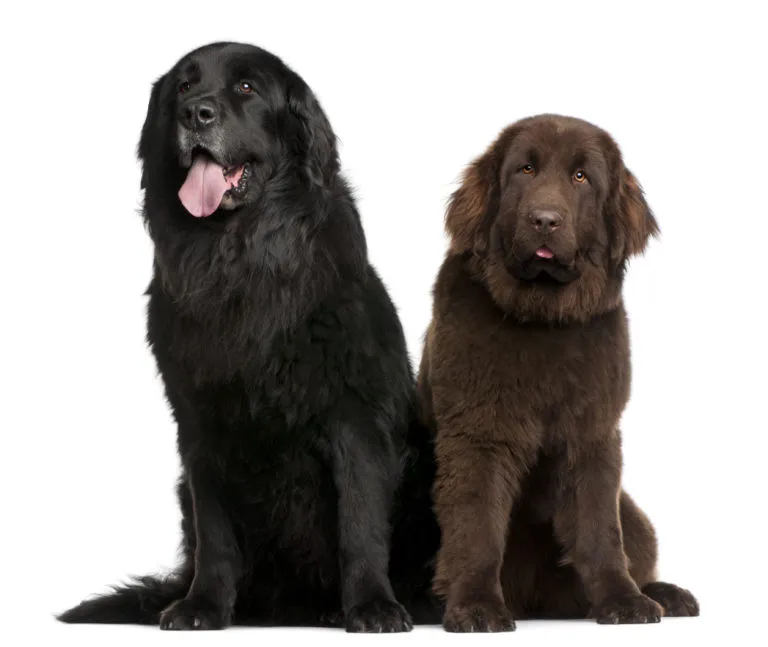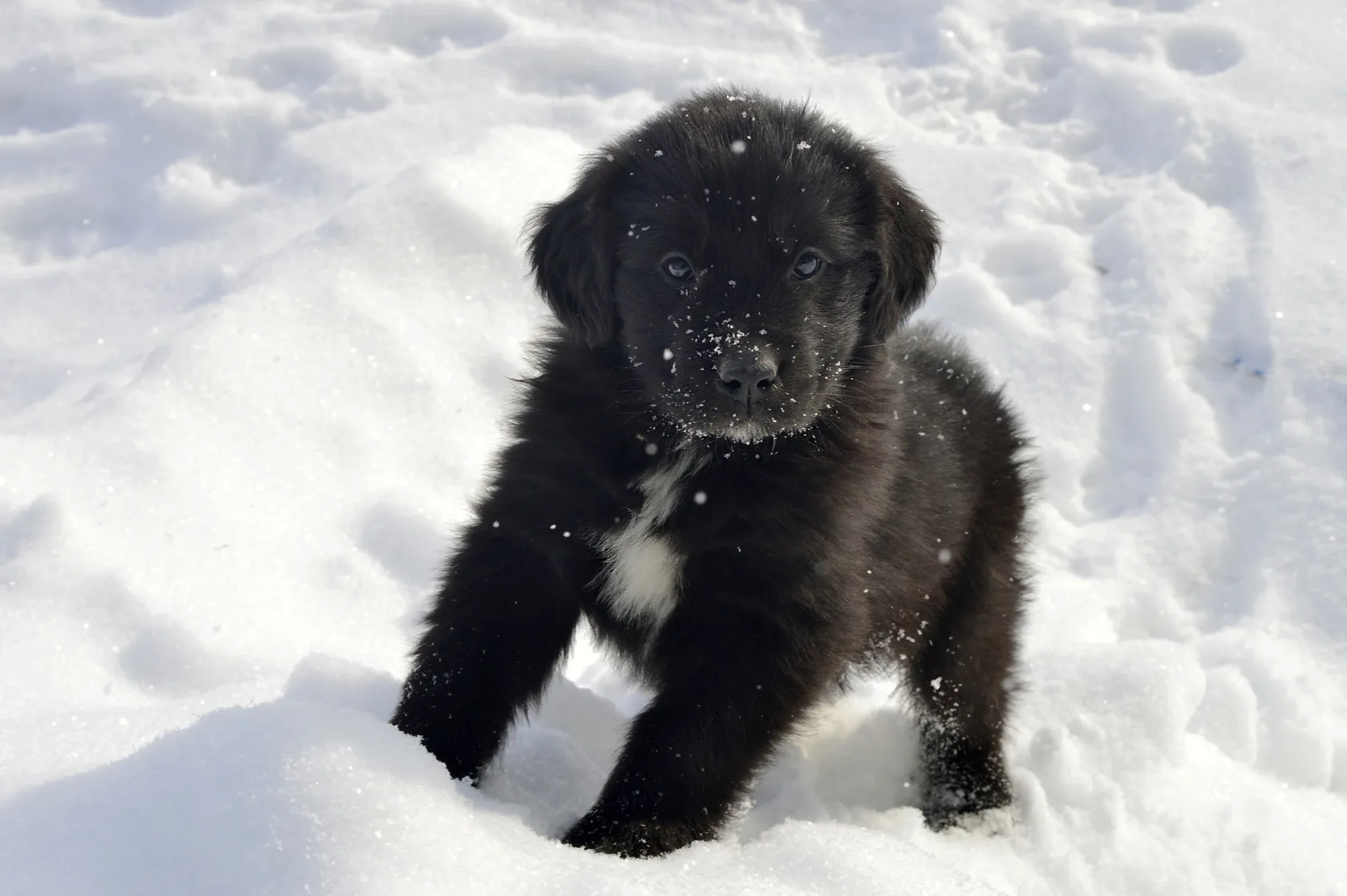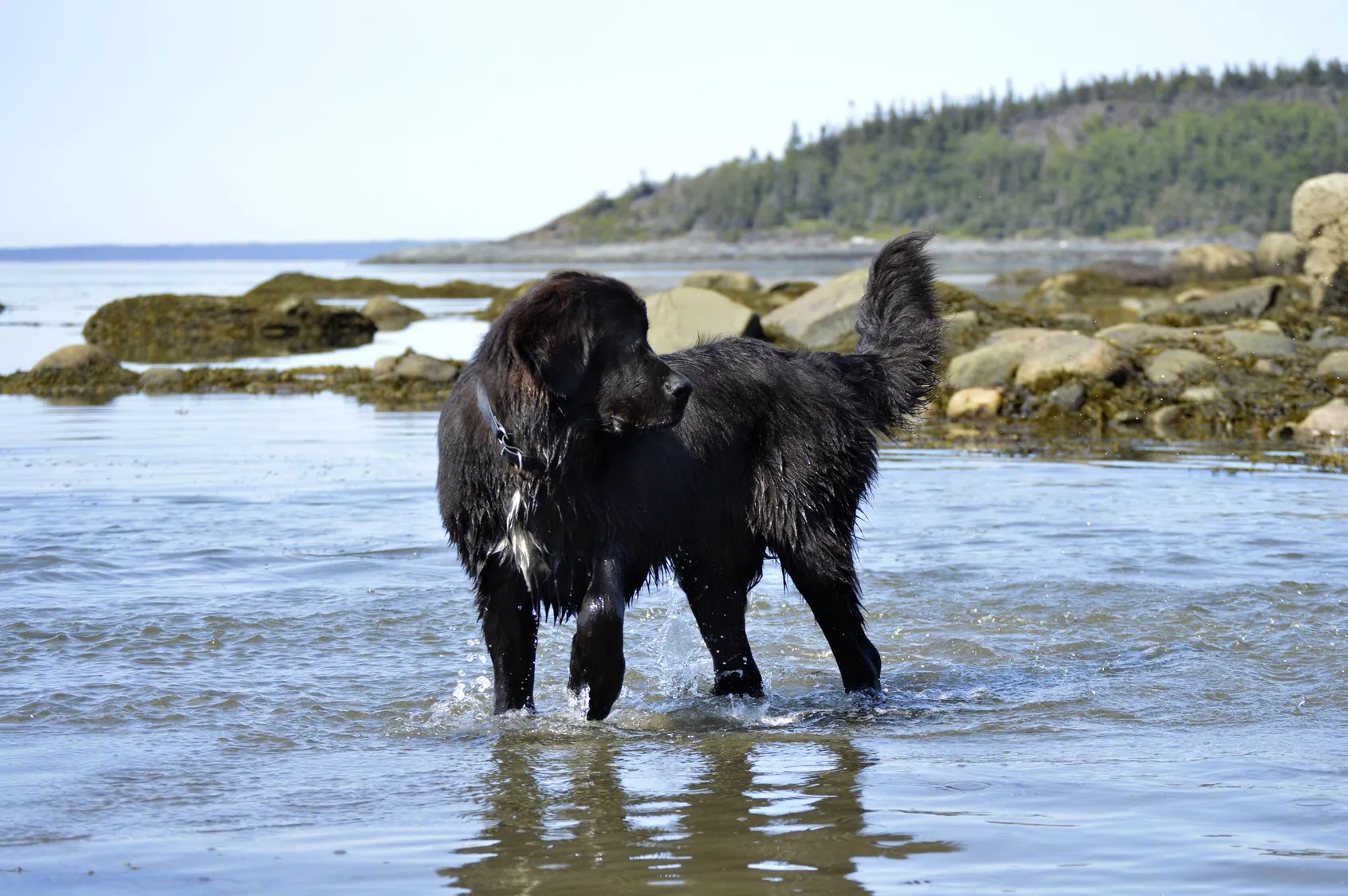Medium Size Poodle
If you would like to own a dog that is strong as a bear and swims like it was born in water, then look no further than the Newfoundland. Originally bred as working dogs to help fisherman in the far north of Canada, these dogs used to help their owners to pull their boats out of the sea. The breed still possesses immense strength and stamina today, as well as a passion for water, even though its working days are largely a thing of the past.

© Eric Isselée / stock.adobe.com
The Newfoundland is best described as a gentle giant. This sweet tempered canine is calm and highly loyal, with an even temperament and their gentle, loving character makes them ideal family dogs. They are known to develop especially close bonds with children, partly due to their enthusiasm for play, but mainly because they are generally patient and considerate when around boisterous youngsters. To feel secure, Newfoundlands need to have a strong bond to their human family, and they reward attention with true loyalty. They really enjoy going everywhere with their humans and adore being cuddled and stroked. In spite of their size and strength, Newfoundlands make great companions thanks to their gentle nature, and they tend not to be aggressive with strangers. This cuddly bear is not one to attack or bite, and they do not even bark very often. Their imposing stature means that they hardly need to bark to make their presence felt.
However, if a Newfoundland senses danger it will not hesitate to protect the people it loves. Given their peaceful nature, Newfoundlands are certainly not guard dog material, but they still show an excellent capacity for independent action and bravery in the face of danger. This, in combination with their passion for swimming, means that this breed is known for being used as water rescue dogs. They are completely comfortable in water and will throw themselves willingly into all types of rivers, streams and the sea, which means that you will not be able to pass by a body of water without your Newfoundland taking a quick dip!
Newfoundlands need lots of outdoor exercise as well as ample opportunities to swim. They are almost impervious to icy temperatures, rain or wind, thanks to their double-layer coat, but this also means that they can feel uncomfortable in warmer temperatures and need to stay in the shade on sunny days.
It is hardly any wonder that the Newfoundland is less than keen on warm weather, as their coat is both super-thick and waterproof, with a soft, insulating undercoat. The heavy coat makes the breed look even bulkier than it really is. The FCI (International Kennel Club) allows three different colours as standard: black, white-black and brown. The black colour is probably the most common, and should be as pure as possible. Historically, the white-black colouring was more common in the breed and led to the development of the ‘Landseer’ breed. The FCI tends to prefer dogs that have a black head with a preference is given to those which can have a black head with a white blaze, a black saddle with a uniform badge, and a black croup. The remaining coat should be white and not too stained. The brown colouring, which does not correspond to the race standard in the home country of Canada, ranges from chocolate brown to an almost bronze-coloured chestnut brown. White badges on the chest, on the toes and at the tip of the tail are allowed in the uniform black or brown dogs. Kennel Clubs in the USA also allow a grey colouring, but this is not yet permitted in Europe, as this can lead to colour dilution alopecia, or so called ‘blue dog syndrome’ (hair loss).
All of the colour variants have a medium-length, straight outer coat (possibly slightly wavy), combined with a coarse yet soft undercoat that becomes thicker in wintertime. Whilst the hair on the head, muzzle and ears is short and fine, the front and hind legs and tail are covered with long, thick hair. The Newfoundland’s big, innocent eyes, as well as its size and thick fur, give it a real ‘teddy-bear’ look. Adult males measure on average 71cm at the withers and adult females are a little smaller at 66cm. The body of an adult female is usually somewhat longer and thus less bulky than that of the male. Bitches still weigh around 54kg, with the average for males being 68kg.
 © Beatrice / stock.adobe.com
© Beatrice / stock.adobe.com
The Newfoundland’s ancestors were known for their strength and stamina. The breed originates in the Canadian Atlantic island province of Newfoundland, where the dogs were used to help fishermen and sailors with their work. The dogs have a waterproof coat and love to swim, and the thickness of the coat meant that even extreme cold, storms and snow did not bother them. These strong water dogs were a reliable help in pulling heavy loads, such as bringing in fishing nets and towing fishing boats out of the water. The Newfoundlands were known for throwing themselves into the icy water again and again, with great enthusiasm and without ever tiring, and their capacity for hard work helped to make them famous outside Newfoundland and further afield.
The exact origins of the Newfoundland breed are unknown, but it is assumed that its ancestors were cross-breeds of the dogs of the first European fishermen to settle in Canada with the dogs of the Micmac and Beothuk indigenous peoples of the region. Cross breeding combined the best aspects of the native island dogs, already adapted for survival in the cold climate, with the characteristics of certain types of dog used by the sailors and fishermen who settled on the island. The thick, insulating undercoat of the Newfoundland is also evidence that they share some of their genes with Arctic sledgedogs, such as the polar dog of the Innu and Inuit. However, the long-held theory that the Newfoundland is descended from large, black bear-like dogs introduced to the region by the Vikings in around 1100AD has since been largely discredited.
The black and white (and sometimes brown-coloured) mongrels that developed as a result of cross-breeding native dog species with European dog breeds were first officially referred to by the name “Newfoundland” in the 18th Century. The first record of the breed being referred to by its current name is in the diary of an English sea captain and settler, George Cartwright, in 1775. Soon afterwards, their reputation as working and rescue dogs spread back to Europe, and sparked an interest amongst the English and French middle and upper classes in the 19th Century. Stories about the Newfoundland’s heroic prowess as a water rescue dog, to which numerous sailors owed their lives, led to the Newfoundland dog being seen as a prestige breed in Europe.
The dogs first appeared at a dog show in Birmingham in 1860 and the Kennel Club started the first breed record fifteen years later. Eleven years afterwards, in 1886, the Newfoundland Club was founded, and it is now one of the world’s oldest continuously registered breed clubs.
Although there is no denying that the breed originated in Canada, England can now be considered the ‘home’ of the Newfoundland, as this is where the original breed records, breed standards and breed aims were laid out. In the international FCI standard, the Newfoundland is at number 50 in group 2 (Pinscher and Schnauzer, Molossoid and Swiss Mountain and Cattle dogs), section 2.2 (Molossoid Mountain type).
If you are interested in acquiring a Newfoundland, you should try to find a reputable breeder that adheres to the strict breed guidelines. Going through a registered breeder helps to ensure that your dog is healthy and has the right characteristics for the breed. The breeder will also ensure that your puppy and its mother receive the best healthcare and that any genetic abnormalities have been ruled out in the pup and its family members. A responsible breeder will also make sure that your puppy receives the best nutrition in the early weeks of life, and help it to become properly socialised. They may also organise for the pup’s first immunisations.
A puppy with pedigree that has enjoyed such meticulous care and attention almost since before conception clearly will not come cheap. Prices vary but you should expect to pay between £900 and £1000+ for a healthy puppy with all of its pedigree certification. If this is not a price that you are prepared to pay, it may be worth enquiring with local animal sanctuaries, as they may receive Newfoundlands for rehoming on occasion. People who are initially attracted to the Newfoundland can sometimes find it difficult to look after such a large dog and regrettably have to give them up. A Newfoundland cross may also be a good option as they generally inherit the breed’s gentle nature without the tendency towards genetic defects of a pure-breed (and they are easy to spot!).
In spite of the best efforts of breeders and vets, Newfoundlands are still prone to a range of genetically inherited defects. As with many large dogs that grow very quickly, Newfoundlands can suffer from joint problems, especially in the hips and elbows. Other orthopaedic complaints such as ligament rupture, dilated cardiomyopathy and bone cancer are also common in the breed.
Even though it is not possible to completely rule these specific illnesses out, you can reduce the risk by purchasing a puppy from a registered breeder, selecting a breed-specific nutrition and taking good advice on the best way to keep and care for your dog. A good breeder should be able to give you tips on training and care and will also provide you with a specific nutrition plan. Changing your puppy’s diet can lead to digestive problems, so if you do decide to change from the food that the breeder provides, you should do it gradually. You should always ensure that you take your dog for regular vet checkups and keep its immunisations up to date.
 © Beatrice / stock.adobe.com
© Beatrice / stock.adobe.com
Newfoundlands are generally pretty robust dogs that are keen to go out in all weathers. Heavy rain, wintry weather and high winds do not bother them one bit. However, when it comes to the heat they are less enthusiastic. The breed developed in northern coastal latitudes and is used to the rawest of conditions, but it is not well adapted to sunshine, because of their thick fur coat. Their coat protects them perfectly against the wind and cold, but it needs constant care to maintain its protective properties. Special brushes need to be used daily to work through the coat and remove dead hair. Breed experts do not recommend combing the Newfoundland’s coat as this can lead to healthy hair being pulled out, causing pain and injury.
It is also important to give their eyes and ears regular care, but dental care is relatively straightforward – the occasional chewy bone should keep their teeth and gums in good condition. If you are considering bringing a Newfoundland into your home then you need to take the time you will need to spend on grooming such a large, hairy animal into account. If you are someone who needs to have a clean and tidy home at all times, then a Newfoundland probably isn’t the right dog for you. These dogs really need a lot of exercise in the fresh air and they also love to swim, so you need to be prepared for the consequences of your dog (and you) frequently getting wet and bringing some of the outdoors indoors with them! A Newfoundland’s dream home would be in the countryside, with a large garden, in easy reach of a suitable swimming spot. It really is not cut out for city life. Unusually for a large dog, this breed is not so much set on going on long hikes with you, but instead what it really craves is the opportunity to have a good swim. Trips to a nearby lake or river, or a holiday by the seaside (at the dog beach of course) will delight your big, hairy pal, and should definitely be planned in on a regular basis.
If you have an active, adventurous, outdoor lifestyle with a family that would love a dog, then the Newfoundland could be for you. Newfoundlands love to go on adventures with their families, especially where water is involved. In fact, probably the only thing that a Newfoundland loves as much as water is the family that gives it a loving home.
Here are some purchase proposals curated by the zooplus editorial team
The products featured have been carefully selected by our editorial staff and are available at the zooplus online pet shop. The selection does not constitute advertising for the mentioned brands.
Fans of the Bearded Collie agree that those who aren't familiar with this dog breed simply have to get acquainted with it. And those who have experienced how a Bearded Collie bolts across meadows with its flowing fur, how it rolls around full of energy and joy and how it attentively and observantly takes into account its owners wishes become simply addicted to this original dog breed and its unique charm.
The Goldendoodle isn't a breed, but a pairing between Golden Retrievers and Medium or Standard Poodles. Marketed as a low-maintenance dog for allergy sufferers, this hybrid is enjoying increasing popularity amongst dog lovers, similar to the Labradoodle.